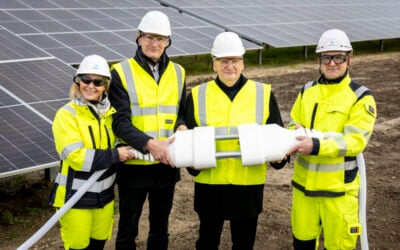The Electric Power Research Institute (EPRI), a US non-profit organisation which is funded by electric utilities, will test and evaluate a battery storage system paired with a 1MW solar array in Cedartown, Georgia.
The project, which EPRI is designing and building, will see a 1MW/2MWh lithium-ion battery-based storage system paired to the PV system. The testing and evaluation process is aimed at setting up a foundation on an economic and technical basis for further deployment of such systems onto the grid, with particular focus on renewable energy integration.
EPRI will partner with utility holding company Southern Company on the project, with the energy storage system scheduled to come online in the second quarter of next year. The solar part of the project consists of 3,388 panels that have an expected annual output of 15,000,000kWh. It was developed by Southern Company’s local subsidiary Georgia Power, under the latter’s Advanced Solar Initiative. The array was designed and built by local turnkey solar installation company Inman Solar.
The system will be owned and operated by Washington Gas Energy Systems (WGESystems), which announced the news last week. A WGESystems spokeswoman told PV Tech that EPRI and Southern Company decided to go ahead with the storage portion of the project and brought WGESystems on board as a “trusted partner”. WGESystems will sell the generated electricity through a 20-year Power Purchase Agreement (PPA). When asked if plans for other, similar projects are already in place or being considered, the spokeswoman said that WGESystems “will continue to evaluate new opportunities”.
Try Premium for just $1
- Full premium access for the first month at only $1
- Converts to an annual rate after 30 days unless cancelled
- Cancel anytime during the trial period
Premium Benefits
- Expert industry analysis and interviews
- Digital access to PV Tech Power journal
- Exclusive event discounts
Or get the full Premium subscription right away
Or continue reading this article for free
Commenting on the project, WGESystems’ chief operating officer, Sanjiv Mahan talked up the significance of the project in evaluating storage for integrating solar.
“The continued research and evaluation of battery storage is a key component to increasing the feasibility of solar energy for individuals, businesses and municipalities,” he said.
“We are committed to renewable energy innovation and look forward to teaming with Southern Company and EPRI to test the battery energy storage system in Cedartown.”
The project (not pictured) was installed by local company Inman Solar. Image: Inman Solar facebook page.
EPRI, as a representative of utility industry, has previously focused researching the technical feasibility of storage projects in the US and elsewhere. The institute actually released a software tool for evaluating the effectiveness of energy storage systems in mid-2013. It has also published a handbook on energy storage in partnership with Sandia National Laboratories, with the latest 340-page edition also surfacing in 2013. Also in partnership with Sandia National Laboratories, EPRI has published an online database of energy storage projects. Both resources can be accessed by the general public.
The latest project could represent an interesting turn of events in the complicated relationship between utilities and solar in the US. The utility companies have long been accused in some quarters of using obstructionist tactics to slow down the widespread deployment of solar, with various lobbying groups alleged to have been used as a front to run anti-solar advertising on their behalf being one example.
In terms of actual deployment of renewables, however, some utilities have been more active than others, with one, Duke Energy acquiring three projects totalling 128MW of capacity this week as part of a US$500 million ‘solar expansion plan’. In fact despite the criticisms, the Solar Electric Power Association (SEPA) reported in April this year that over 80% of new PV generation capacity installed in the US in 2013 came from utilities.
At the beginning of this year, PV Tech Storage interviewed Haresh Kamath, who is programme manager for energy storage at EPRI and co-authored the aforementioned energy storage handbook and worked on the evaluation software tool. He said 2014 could be a pivotal year for energy storage, particularly in terms of integrating renewable energy.
A spokeswoman said WGESystems will continue to “evaluate new opportunities” for similar projects. Image: WGESystems.
“This will be the year that storage has to really put up or shut up,” Kamath said.
“People will be looking very carefully to see if we can make an economic case for energy storage, given that it’s relatively expensive – are the costs going to come down and are there going to be other benefits for the grid?”
Kamath said at the time that while the need to rapidly accommodate renewables was not being as acutely felt in most of the US as elsewhere, the problems were likely to surface in a handful of years.
“From a technical standpoint, most of this is not of immediate concern in 2014, there’s nowhere that the grid is being threatened by the penetration of solar today, but certainly grid operators and other people are looking into the future and saying, in five or six years we’ve really got to understand how we’re going to make the grid reliable.
“They are looking at energy storage as a flexibility resource to address that. Things have turned from the way people talked five years ago. People should no longer talk about the mitigation of the effects of renewables, we’re talking about making the grid more flexible to accommodate more renewables,” he said.
Kamath also said at the time however that while the technical case for storage was one thing, the economic case for it was another case entirely, that would likely require regulatory assistance.
“…People will be looking very carefully to see if we can make an economic case for energy storage, given that it’s relatively expensive, are the costs going to come down and are there going to be other benefits for the grid when they put down that storage on the grid. Can they make a strong economic case for it?
“As with anything in this business, that’s very closely tied to the regulatory treatment of energy storage. This is where a lot of the developments are very interesting. We’ve seen some interesting technology over the last few years – on the technological front there’s a lot of great stuff going on – but there are only a few technologies really that are mature enough to be deployed very broadly at this stage and we know what they are.
“The real question is going to be, are there regulatory incentives in place to make those technologies viable in terms of deployment?”





